 |
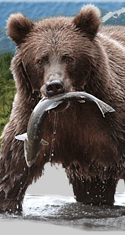 |
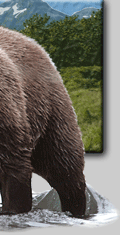 |
||||||||
 |
 |
 |
 |
|||||||
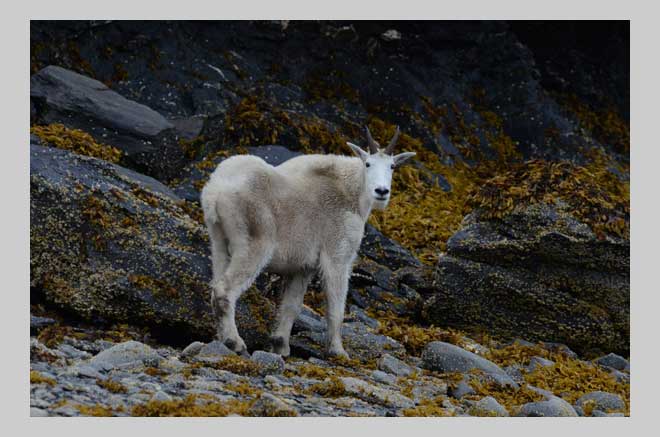 |
|
The mountain goat (Oreamnos amricanus) is a member of the antelope family,[1] and it is the only North American species representing the Rupicaprinae or "rock goats", a group of mountain ungulates.[2] Mountain goats were not described in the scientific literature until 1816, and they are one of the least-studied large mammals in North America, mainly because they live in remote, rugged areas that are difficult to access.[2] It is estimated that 100,000 mountain goats live in North America.[1] They occupy steep mountain ranges from the Cascade and Rocky Mountains to Southcentral Alaska. Mountain goats occur naturally in the Southeast Panhandle and north and west to Cook Inlet. In Southcentral Alaska, goats can be found in the Chugach and Wrangell mountains. Mountain goats have been successfully introduced to Baranof Island and to Kodiak Island.[2] From 1952 to 1953, eleven female and seven male goats were transplanted from the Kenai Peninsula to Hidden Basin near the head of Ugak Bay, approximately 30 miles from the town of Kodiak on Kodiak Island.[3] After a few severe winters, it was uncertain whether any of the transplanted goats had survived, but a 1964 aerial survey counted 26 goats. By 1972, the population on the island was estimated at 100. Limited goat hunting began in the late 1960's, but the goat population continued to increase and expand. By 2004, the population was estimated at 1560 goats, and by 2013, it had increased to 2500 animals.[3] Goats now occupy every suitable habitat on Kodiak, and biologists are concerned that there are too many goats for the habitat to sustain.[4] A mountain goat is characterized by a long face, relatively short horns, a short tail, and beard-like hair on its chin.[1] Both males and females have horns, but a female's horns are more slender, and they bend back more sharply at the tip.[2] Horns have a bony core covered with a sheath of keratin. Unlike antlers, horns don't branch, and they are never shed. Mountain goat horns never stop growing, and the rings on the horns can be used to age the animal.[5] The coat of a mountain goat consists of two layers, a thinner undercoat and a heavy, long, wooly overcoat to keep it warm at high elevations in the winter. A crest of hair, eight or more inches long runs along the spine and rump and over the shoulders and neck. Bushy, long hair also covers the legs. They begin shedding their heavy outer layer of fur in June.[2] Male and female goats look very similar, but males, on the average, are 40% larger than females. Adult females average 180 lbs. (81.82 kg), while males average 280 lbs. ( 127.27 kg), and males in their prime often weigh over 300 lbs. (136.36 kg).[2] The largest male ever weighed was 385 lbs. (175 kg), and the largest female weighed 260 lbs. (118.18 kg).[4] Goat weight also varies depending on the time of year. Research shows that goats gain approximately one-half pound (.23 kg) a day in late summer, and the weight for a mature male can increase from 260 to 300 lbs. (118.18 to 136.36 kg) between August 1st and October 15th.[4]
Mountain goat hooves have a keratinous sheath with a soft, embedded pad that allows them to grip and climb steep, slick, rocky cliffs.[2] Goats are active during the day and night and move in response to changing seasons and available food.[1] They generally have small home ranges and high site fidelity. In other words, while they move between summer and winter ranges, they prefer the same areas year after year.[4] One exception to this is in areas where goat populations are expanding and the goats are pioneering new, suitable habitat.[4] Another exception is during the mating season when billies may travel a considerable distance in search of receptive nannies.[2] In the summer, goats inhabit high alpine ranges, but in the winter, they may move down to the tree line where they can find forage, or to windswept ridges with little or no snow cover where they can find food.[2]
Interestingly, while steep mountain cliffs are barriers to most animals, they are the preferred habitat of goats. Forested valleys, on the other hand, tend to be barriers to goats, because goats live not only where they can find an adequate food supply but also where they can quickly and easily escape predators such as bears and wolves. The steep slopes where goats live are easy for them to maneuver but are inaccessible to predators.[4] |
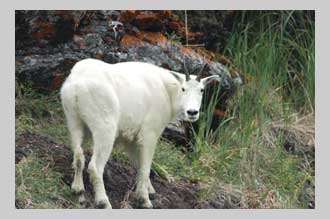 |
Mountain goats are considered to be both grazers and browsers. They eat sedges, ferns, mosses, and lichens.[2] They spend their summers in the high alpine meadows where they consume sedges, forbs, and shrubs. During the winter when there is less food available, goats eat whatever they can find, including blueberry, hemlock, and lichens.[2] Recent research on Kodiak indicates that fern rhizomes are an important part of the goats' diet in early summer before and during vegetative green-up, but as the summer progresses, goats switch from ferns to sedges and forbs. Goats particularly seem to favor feeding sites with abundant long-awned sedge (Carex macrochaeta).[6] Breeding season for goats occurs between late October and early December.[2] Unlike black-tailed deer, moose, and caribou, goats do not give birth until they are at least four-years old,[2] and young mothers are less successful than older nannies at keeping their kids alive past the age of one. Young nannies also tend to skip a year between births, while 80% of nine-to-eleven-year-old nannies have a kid each year.[4] Billies between the ages of five and ten do most of the breeding,[2] but bigger, older billies tend to be more successful at impregnating females.[4] Mountain goats seem to avoid mating with relatives,[4] and billies may travel long distances to find suitable mates. This behavior helps to increase the genetic diversity of isolated populations. Males will breed with several females, but nannies breed with only one male.[2] Pregnant nannies give birth in mid to late May after a gestation period of 180 days.[2] Nannies normally have only one kid but sometimes produce twins.[2] Twinning is more common when goat populations spread into a new habitat with an abundant food supply, and as the goat population on Kodiak has increased and expanded its range across the island, biologists have noted more twinning than is normal.[4] Nannies seek out an isolated area to give birth but then find other nannies and kids to form nursery groups, while males either remain solitary, well away from the nannies and kids or form small bachelor groups with a few other billies. A kid remains with his mother at least until the next breeding season and may stay with her for several years.[2] Mountain goats live an average of twelve years but may live as long as eighteen years.[2] They inhabit an extreme environment that harbors a number of threats. Biologists note that some of the main causes of death for goats include malnutrition, bear and wolf predation (although on Kodiak, there are no wolves), avalanches, falling, and human hunters.[4] The ability to survive the winter depends on the goat's body condition in the fall and the winter food supply. Mortality spikes in October during the first snowfalls, and biologists surmise this is probably due to avalanches and the risks of traveling between summer and winter ranges, possibly through bear habitat.[4] There is an even larger spike in mortality in late winter when malnutrition becomes a greater threat. Mortality also tends to be higher after a hot summer, and this may be because the most nutritious forage occurs at the edges of snow patches. If it is cooler and the snow recedes more slowly, the period of early-growth sprouting lasts longer than it does when the temperatures are warmer and all the snow melts at once.[4] Warm summers also cause heat stress. |
|
As I mentioned earlier, mountain goats are one of the least-studied large mammals in North America, but that is beginning to change. In Washington state, mountain goats are native to the Cascade Mountains and were introduced to the Olympic Mountains. In the 1960's, hunters took nearly 400 goats per year, which turned out to be an unsustainable harvest and nearly decimated the population. Research on mountain goats in that area is focused on ways to increase the number of goats.[4] In British Columbia and Southeast Alaska, helicopter logging and helicopter-access skiing are widespread activities, so goat research in that area is focused on understanding winter and summer goat habitat and determining how much helicopter activity disturbs goats during the various seasons.[4] On Kodiak, goat research is focused on a very different problem. The goat population on Kodiak continues to grow, and mountain goats have dramatically expanded their range in recent years. Introduced species like mountain goats can have negative impacts on native plants and animals, and biologists are concerned that a high density of mountain goats could adversely impact alpine areas where the slopes are steep and there is not much soil. There is very little vegetation to begin with in this habitat, and goats could easily over-graze the plants that are there.[7] Not only could over-grazing be irreversibly detrimental to the habitat, but it could and probably would cause a crash in the goat population. Researchers are trying to determine how many goats the alpine habitat on Kodiak can support, or in scientific terms, they want to find the carrying capacity for mountain goats on Kodiak. Biologists are concerned that mountain goats may have already exceeded their carrying capacity on the island, and current ongoing research by the U.S. Fish and Wildlife Service and the Alaska Department of Fish and Game is focused on better understanding exactly what and how much a goat eats over the course of a year.[6] Researchers collect and study fecal pellets to determine what plants the goats are eating and the proportions of the different plants in their diet. Additionally, 15 goats were fitted with VHF and GPS collars. The state-of-the-art GPS collars record an animal's location every hour, and the data can be retrieved by locating the animal by airplane and downloading the information onto a laptop. This allows scientists to make a detailed map of each animal's movements.[3] Researchers are also studying the nutritional value of all plants that make up more than 5% of mountain-goat diets as well as weighing the plants to assess the potential nutritional capacity of the various goat habitats. Biologists hope to use all of this information to predict the number of goats a particular habitat can support.[7] Goat habitat is difficult and sometimes impossible for humans to access, so tools such as downloadable GPS collars are invaluable in better understanding this interesting animal. |
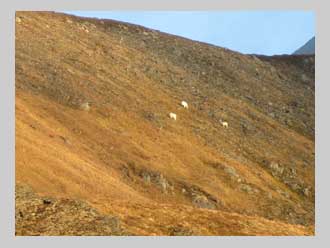 |
|
Literature Cited 1. Mountain Goat Fact Sheet. Available at: www.defenders.org/mountain-goats/basic-facts 2. Mountain Goat (Oreamnos americanus): Species Profile. Alaska Department of Fish and Game. Available at: www.adfg.alaska.gov/index.cfm?adfg=goat.main 3. Woodford, Riley. Mountain Goat Research on Kodiak Island. Alaska Fish and Wildlife News. Alaska Department of Fish and Game. Available at: www.adfg.alaska.gov/index.cfm?adfg=wildlifenews.view_articles&articles_id=635 4. Woodford, Riley. Mountain Goats in Focus. Biologists Share Management and Research. Alaska Fish and Wildlife News. Alaska Department of Fish and Game. Available at: www.adfg.alaska.gov/index.cfm?adfg=wildlifenews.view_article&articles_id=547 5. Horns and Antlers. Animal Diversity Web. University of Michigan Museum of Zoology. Available at: animaldiversity.ummz.umich.edu/collections/mammal_anatomy/horns_and_antlers/ 6. Cobb, McCrea, H.Helling, and B. Pyle. Kodiak Island Mountain Goat Behavior, Diet, and Feeding Site Selection Patterns. Alaska Refuges Report #, 2012. Available at: www.fws.gov/uploadedfiles/region_7/nwrs/zone_2/kodiak/pdf/mtgoatannualreport2011.pdf 7. Kodiak: The Refuge's Ground-breaking Mountain Goat Research. 2012. U.S. Fish & Wildlife Service Field Notes. Available at: www.fws.gov/fieldnotes/regmap.cfm?arskey=32936 |
Text by Robin Barefield
Photos by Mike Munsey
Copyright 2012 Munsey's Bear Camp